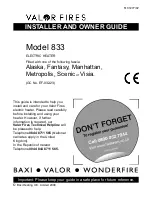
8 Inspection and maintenance
16
Installation and maintenance instructions atmoMAG 0020273765_00
8.9
Cleaning the heat exchanger
1.
Use a spray of water to rinse through the fins of the
heat exchanger.
2.
Use a soft brush to remove the heavier soiling on the
fins of the heat exchanger.
–
Ensure that you do not bend the fins on the heat
exchanger.
3.
If required/necessary, remove any grease and dust by
adding a fat-dissolving cleaning agent to a container of
hot water.
4.
Use a commercial descaler to remove any limescale,
while taking into consideration the corresponding docu-
mentation.
5.
Rinse the heat exchanger under running water.
8.10
Repairing any damage to the coating of the
heat exchanger
1.
Use a Supral pen to repair minor damage to the heat
exchanger coating.
2.
Ensure that the damaged area is free from deposits and
greasy residues.
3.
Shake the Supral pen vigorously before use.
4.
Apply the coating material thinly and evenly.
8.11
Checking the water valve
A
B
2
3
1
1.
Remove the cold water connection line from the cold
water connection
(2)
.
2.
Visually check the cold water strainer
(3)
that is down-
stream of the cold water connection for dirt and scale.
3.
If the cold water strainer is dirty or calcified, remove the
clamp
(1)
and pull out the cold water connection.
4.
Remove the cold water strainer from the cold water
connection and clean the cold water strainer.
5.
Reinsert the cold water strainer into the cold water con-
nection.
6.
Reinsert the cold water connection into the product's
retainer and secure the clip.
7.
Secure the cold water connection line to the cold water
connection again.
8.
Check whether the temperature selector spindle can be
turned. Otherwise, loosen the clamps on the temperat-
ure selector spindle, remove these and clean the tem-
perature selector spindle.
9.
Check the stuffing box for tightness. If a stuffing box is
leaking, replace the water valve.
8.12
Checking the heat input
▶
Check the heat input either by reading off the gas flow
values at the counter (volumetric method) or by checking
the burner pressure (burner pressure test method).
Volumetric method
1
2
▶
When carrying out the check, ensure that no additional
gases (e.g. mixtures of liquid gas and air) are fed in to
cover the peak demand. Contact the responsible gas
supply company for this.
▶
Ensure that no other gas-fired boilers are operated during
the check.
▶
Start up the product.
▶
Turn the temperature selector
(1)
clockwise as far as it
will go in order to reduce the water volume and set the
maximum water temperature.
▶
Turn the rotary power switch
(2)
as far as it will go anti-
clockwise to set the maximum product output.
▶
Determine the required gas flow value at nominal heat
input in accordance with the tables of gas settings in the
appendix.
▶
Note down the gas meter reading.
▶
Draw off domestic hot water with the water tap fully open
to enable the nominal water volume to flow (
→
Technical
data).
▶
After approx. five minutes of the product running in
continuous operation, read off the gas flow value at
the meter and compare this with the gas flow value at
nominal heat input in the tables of gas settings in the
appendix.
Note
Deviations of
±
5% are permitted.













































